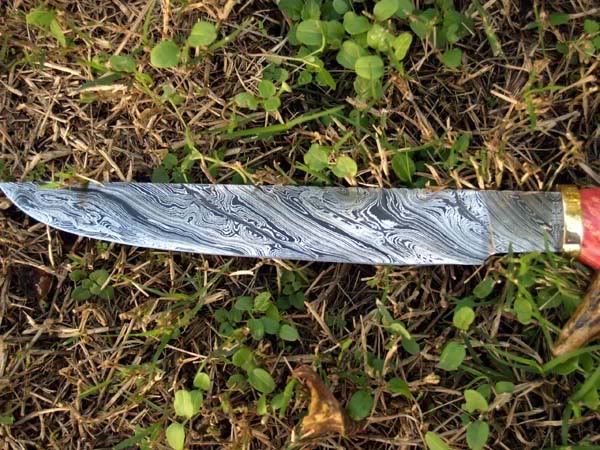You are using an out of date browser. It may not display this or other websites correctly.
You should upgrade or use an alternative browser.
You should upgrade or use an alternative browser.
Damascus knives..
- Thread starter RickD
- Start date

Help Support Muzzleloading Forum:
This site may earn a commission from merchant affiliate
links, including eBay, Amazon, and others.
RickD said:Not sure where to ask this question but where damascus knives used and if so what time period..
Rick,
Damascus knives on the American continent are pretty much a 20 century item. Certainly not 18th or early to mid 19th century.
Randy Hedden
Brian Rice
36 Cal.
- Joined
- Jan 1, 2005
- Messages
- 71
- Reaction score
- 0
When you go totaly PC or HC, don't forget about that Hawk Knife I want to talk you out of. LOL!!!!!
Did you get my email with the addresses?
Did you get my email with the addresses?
Goldhunter
54 Cal.
- Joined
- Mar 27, 2006
- Messages
- 1,596
- Reaction score
- 6
Gray wolf, on the following like, mentioned Shear Steel. I like Damascus and the edge it takes. If you like the knife, why not refinish the blade by taking the layer markss off? Sand/file the marks off and then sand to a smooth finish? Just a thought.
[url] http://www.muzzleloadingforum.com/fusionbb/showtopic.php?tid/192673/post/257013/hl[/url]//
[url] http://www.muzzleloadingforum.com/fusionbb/showtopic.php?tid/192673/post/257013/hl[/url]//
Last edited by a moderator:
Well if I did that it kind of defeats the purpose of having a damascus blade..I like the looks of damascus and I`m really not into PC..I think I have 7 damascus knives and two knives made from 1095 steel and a few store knives that I picked up in my wanderings..
Brian Rice
36 Cal.
- Joined
- Jan 1, 2005
- Messages
- 71
- Reaction score
- 0
I saw Andy's knife! Very nice!!!RickD said:Hey Brian,
The hawk knife is yours when I get tired of it,may be a while..I also got the address you supplied..While we are on the knife subject I got another new one and placed an order for another..
What else did you order????
Well, we can't quite make a blanket declaration of NO on damascus knives, but there are several things to consider with them.
Some examples of forge-welded damascus knives do exist from the 18th and 19th centuries, but not too common. There are also examples of knives that were made from several small pieces of steel that were welded together to have enough steel to make the final knife. These weren't intended to be a "damascus" knife, but if you etch the blade you can see layers and areas of different types of steel. And there were still knives around made in the area of Damascus from Wootz steel - the original damascus steel. This was iron that was melted and then shavings of steel mixed in.
The main thing to remember is that those early damascus knives were made that way for the quality of the steel, not for the "patterned" look. The final blade was smoothed and polished. You would not see any patterns in the steel - until after much use and patina. The modern damascus knives are made for the quality of the steel, but also to specifically show the patterns. So they are polished and then etched with acids to show that pattern.
So, if you polish the knife blade up so that you can't see the patterns, then the knife will fit in historically (depending upon shape/style). But, as you pointed out, that now defeats the visual reason to have a damascus knife.
So it goes.
Just my humble thoughts to share.
yhs
Mike Ameling
Some examples of forge-welded damascus knives do exist from the 18th and 19th centuries, but not too common. There are also examples of knives that were made from several small pieces of steel that were welded together to have enough steel to make the final knife. These weren't intended to be a "damascus" knife, but if you etch the blade you can see layers and areas of different types of steel. And there were still knives around made in the area of Damascus from Wootz steel - the original damascus steel. This was iron that was melted and then shavings of steel mixed in.
The main thing to remember is that those early damascus knives were made that way for the quality of the steel, not for the "patterned" look. The final blade was smoothed and polished. You would not see any patterns in the steel - until after much use and patina. The modern damascus knives are made for the quality of the steel, but also to specifically show the patterns. So they are polished and then etched with acids to show that pattern.
So, if you polish the knife blade up so that you can't see the patterns, then the knife will fit in historically (depending upon shape/style). But, as you pointed out, that now defeats the visual reason to have a damascus knife.
So it goes.
Just my humble thoughts to share.
yhs
Mike Ameling
Similar threads
- Replies
- 4
- Views
- 369
- Replies
- 0
- Views
- 601





